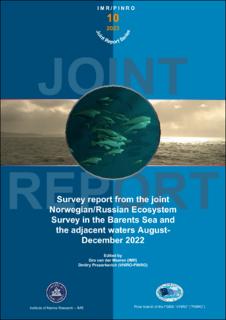| dc.contributor.author | Johansen, Geir Odd | |
| dc.contributor.author | Trofimov, Alexander | |
| dc.contributor.author | Ingvaldsen, Randi Brunvær | |
| dc.contributor.author | Prokhorova, Tatiana | |
| dc.contributor.author | Grøsvik, Bjørn Einar | |
| dc.contributor.author | Krivosheya, Pavel | |
| dc.contributor.author | Bagøien, Espen | |
| dc.contributor.author | Lerch, Sarah Joanne | |
| dc.contributor.author | Prokopchuk, Irina | |
| dc.contributor.author | Eriksen, Elena | |
| dc.contributor.author | Husson, Berengere | |
| dc.contributor.author | Skaret, Georg | |
| dc.contributor.author | Johannesen, Edda | |
| dc.contributor.author | Bogstad, Bjarte | |
| dc.contributor.author | Windsland, Kristin | |
| dc.contributor.author | Höffle, Hannes | |
| dc.contributor.author | Wienerroither, Rupert | |
| dc.contributor.author | Hvingel, Carsten | |
| dc.contributor.author | Dolgov, Andrey | |
| dc.contributor.author | Hjelset, Ann Merete | |
| dc.contributor.author | Bakanev, Sergey | |
| dc.contributor.author | Stesko, Aleksei | |
| dc.contributor.author | Jørgensen, Lis Lindal | |
| dc.contributor.author | Øien, Nils Inge | |
| dc.contributor.author | Boehm, Frederike | |
| dc.contributor.author | Strelkova, Natalia | |
| dc.contributor.author | Blinova, Daria | |
| dc.contributor.author | Klepikovskiy, Roman | |
| dc.contributor.author | Fauchald, Per | |
| dc.contributor.editor | Prozorkevich, Dmitry | |
| dc.contributor.editor | van der Meeren, Gro Ingleid | |
| dc.date.accessioned | 2023-11-09T07:24:03Z | |
| dc.date.available | 2023-11-09T07:24:03Z | |
| dc.date.created | 2023-11-08T10:28:27Z | |
| dc.date.issued | 2023 | |
| dc.identifier.uri | https://hdl.handle.net/11250/3101537 | |
| dc.description.abstract | The aim of the joint Norwegian/Russian ecosystem survey in the Barents Sea and adjacent waters, August-October (BESS) is to monitor the status and changes in the Barents Sea ecosystem and provide data to support stock advice and research. The survey has since 2004 been conducted annually in the autumn, as a collaboration between the Institute of Marine Research (IMR) in Norway and the Polar branch of the VNIRO (PINRO) in Russia. The general survey plan and tasks were agreed upon at the annual IMR-PINRO Meeting in March 2022. Ship routes and other technical details are agreed on by correspondence between the survey coordinators. BESS aims at covering the entire Barents Sea. Ecosystem stations are distributed in a 35×35 nautical mile regular grid, and the ship tracks follow this design. Exceptions are the area around Svalbard (Spitsbergen), some additional bottom trawl hauls for demersal fish survey indices estimation, and additional acoustic transects for the capelin stock size estimation. Survey start for the Russian vessel was significantly delayed, resulting in REEZ being covered two-three months later than NEEZ. This resulted in reduced area coverage, decrease in the numbers of trawl hauls, and lack of standard pelagic trawl sampling. In NEEZ, RV “Kronprins Haakon” was cancelled due to difficult economic situation, making it necessary to allocate one of the two remaining vessels to the area west and north of Svalbard (Spitsbergen). This resulted in low coverage in this area, and problems with synoptic coverage in north-east of Svalbard (Spitsbergen) and thus increased uncertainty in assessment of demersal fish (e.g. Greenland halibut) and capelin. The 19-th joint Barents Sea autumn Ecosystem Survey (BESS) was carried out in two periods. The Norwegian research vessels “G.O. Sars” and “Johan Hjort” covered NEEZ in the period 16-th August to 03-th October, providing data to stock assessment, 0-group fish abundance indices, and state and changes descriptions which is comparable with earlier survey years in NEEZ. The Russian research vessel “Vilnyus” covered REEZ in the periods 20-th to 30-th September and 22-th October to 3-rd December. Survey coordinators in 2022 were Dmitry Prozorkevich (PINRO) and Geir Odd Johansen (IMR). Exchange of Russian and Norwegian experts between each country’s respective vessels did not take place in 2022. We would like to express our sincere gratitude to all the crew and scientific personnel onboard RVs “Vilnyus”, “G.O. Sars” and “Johan Hjort” for their dedicated work, as well as all the people involved in planning and reporting of BESS 2022. This report is a summary of observations and status assessment based on the survey data. Even though the survey was not well completed, the data obtained are the main source of knowledge about the ecosystem of the Barents Sea. | |
| dc.description.abstract | Survey report from the joint Norwegian/Russian Ecosystem Survey in the Barents Sea and the adjacent waters August- December 2022 | |
| dc.language.iso | eng | |
| dc.publisher | Havforskningsinstituttet | |
| dc.relation.ispartof | IMR/PINRO Joint Report Series | |
| dc.relation.ispartofseries | IMR/PINRO Joint Report Series | |
| dc.relation.uri | https://www.hi.no/hi/nettrapporter/imr-pinro-en-2023-10 | |
| dc.title | Survey report from the joint Norwegian/Russian Ecosystem Survey in the Barents Sea and the adjacent waters August- December 2022 | |
| dc.title.alternative | Survey report from the joint Norwegian/Russian Ecosystem Survey in the Barents Sea and the adjacent waters August- December 2022 | |
| dc.title.alternative | Toktrapport fra det norsk/russiske økotoktet i Barentshavet og nærliggende områder | |
| dc.type | Research report | |
| dc.description.version | publishedVersion | |
| dc.source.pagenumber | 97 | |
| dc.source.issue | 2023 - 10 | |
| dc.identifier.cristin | 2193727 | |
| cristin.ispublished | true | |
| cristin.fulltext | original | |
